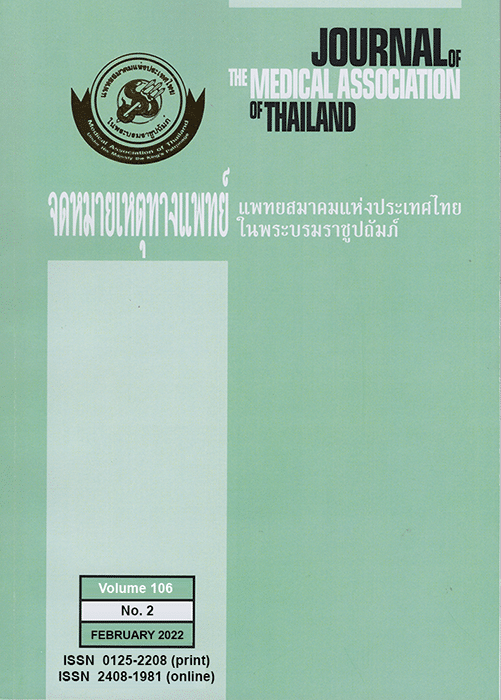
Correlation between transperineal and transvaginal sonography in cervical length measurement among normal thai pregnant women at 16 to 24 weeks of gestation (2018)
Title : Correlation between transperineal and transvaginal sonography in cervical length measurement among normal thai pregnant women at 16 to 24 weeks of gestation
Researcher : Kovavisarach, E., Kedthong, R.
Abstract : Background: Currently, cervical length is generally measured by transvaginal sonography (TVS) to predict preterm labor. Transperineal sonography (TPS) has been proposed as an alternative modality to TVS.
Objective: To compare cervical length measurements and pain scores of TPS and TVS in normal Thai pregnant women
Material and Method: A total of 40 normal Thai pregnant singleton women were enrolled at the antenatal clinic, Rajavithi Hospital between 1st December 2014 and 28th February 2015 at 16 to 24 weeks of gestation. Patients were excluded if they had history of and proved rupture of membranes, body mass index (BMI) >30 kg/m2, antepartum hemorrhage, or mass at perineum. The TPS and TVS techniques for cervical length measurement were performed in all cases by a single researcher (RK). Visual analog scale (VAS) score was used to assess the pain score (total = 10).
Results: Mean cervical lengths measured by TVS were slightly greater than those found using TPS (37.80 mm and 35.73 mm, respectively). The Pearson’s correlation coefficient between the two methods was 0.746, p<0.01. Mean pain scores determined by VAS score in TPS and TVS were 0.15 and 0.03, respectively (p = 0.02). The number of people whose VAS score was zero was similar with both methods (87.2% and 71.8%, respectively) (p = 0.095).
Conclusion: TPS could be used as an alternative method of TVS to assess CL in normal Thai pregnant women at 16 to 24 weeks of gestation because of its good correlation coefficient and lower pain levels.
Keywords: Cervical length, Transperineal sonography, Transvaginal sonography
Link to Academic article: http://www.jmatonline.com/index.php/jmat/article/view/9089
Journal : Journal of the Medical Association of Thailand, 2018, 101(Suppl.2)
Bibliography : Kovavisarach, E., & Kedthong, R. (2018). Correlation between transperineal and transvaginal sonography in cervical length measurement among normal thai pregnant women at 16 to 24 weeks of gestation. Journal of the Medical Association of Thailand, 101(Suppl.2), S19–S23.
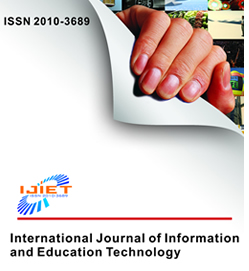
Creating and Collecting e-Learning Event Logs to Analyze Learning Behavior of Students through Process Mining (2023)
Title : Creating and Collecting e-Learning Event Logs to Analyze Learning Behavior of Students through Process Mining
Researcher : Nammakhunt, A., Porouhan, P., Premchaiswadi, W.
Department : Doctor of Philosophy Program in Information Technologyy, Graduate School, Siam University
E-mail :
ฐานข้อมูลงานวิจัย มหาวิทยาลัยสยาม : https://e-research.siam.edu/kb/creating-and-collecting-e-learning/
Link to article: International Journal of Information and Education Technology, 2023, 13(2), pp. 211–222, 1798. https://doi.org/10.18178/ijiet.2023.13.2.1798
Publication: International Journal of Information and Education Technology / in Scopus
Bibliography : Nammakhunt, A., Porouhan, P., Premchaiswadi, W. (2023). Creating and Collecting e-Learning Event Logs to Analyze Learning Behavior of Students through Process Mining. International Journal of Information and Education Technology, 13(2), 211–222, 1798. https://doi.org/10.18178/ijiet.2023.13.2.1798
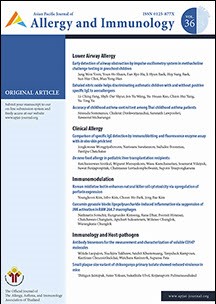
De novo food allergy in pediatric liver transplantation recipients (2018)
Title : De novo food allergy in pediatric liver transplantation recipients
Researcher : Clin.Prof.Suwat Benjaponpitak
Department : Faculty of Medicine, Siam University, Bangkok, Thailand
E-mail : med@siam.edu
Abstract : Background: Food allergy (FA) prevalence is increasing in pediatric liver transplantation (LT). However, the clinical course is still limited.
Objective: This retrospective cohort study aimed to identify the prevalence, risk factors, and the natural history of de novo FA in children post LT.
Methods: Medical records of pediatric LT recipients from Jan 2001 – Dec 2014 were reviewed. De novo FA was diagnosed by symptoms after exposure to culprit food occurring after LT, and improvement after diet elimination. FA was confirmed if reproduced symptoms after re-challenge or documented sensitization or indicated gastrointestinal eosinophilia.
Results: Among 46 post LT children, 54.3% developed de novo FA at a median time of 12.2 months [Interquartile range (IQR) 6.2, 21.3 months] post LT. The confirmed FA was 39.1%. Gastrointestinal symptom was the most common manifestation followed by skin, anaphylaxis, and others. Culprit foods were cow’s milk, shellfish, egg, wheat, soybean, peanut, coconut, fish and monosodium glutamate. The risk factors of FA were transplantation during age below 2 years [hazard ratio (HR), 2.62; 95% confidence interval (CI), 1.04 – 6.59; p = 0.03), atopic history in family (HR, 5.67; 95% CI, 1.33 – 24.12; p = 0.01), and Epstein-Barr (EBV) viremia (HR, 2.39; 95% CI, 1.02 – 5.63; p = 0.04).
Conclusions: de novo FA in pediatric LT is not uncommon. Age at LT younger than 2 years, family history of atopy, and EBV viremia are associated with developing FA. Development of tolerance after elimination culprit diets for 3 years is similar to general population.
Key words: Food allergy, liver transplantation, tolerance, outgrown, de novo food allergy
Link to Academic article: DOI: 10.12932/AP-080217-0007
Journal : Asian Pacific journal of allergy and immunology
Bibliography : Sinitkul, R., Manuyakorn, W., Kamchaisatian, W., Vilaiyuk, S., Benjaponpitak, S., Lertudompholwanit, C., & Treepongkaruna, S. (2018, September). De novo food allergy in pediatric liver transplantation recipients. Asian Pac J Allergy Immunol, 36(3), 166-174. doi: 10.12932/AP-080217-0007. PMID: 29161056.
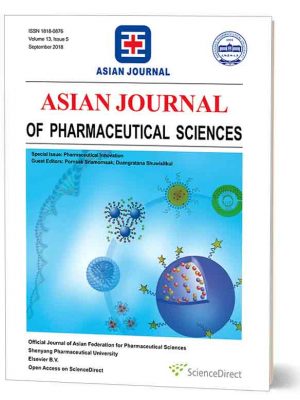
Design and characterization of monolaurin loaded electrospun shellac nanofibers with antimicrobial activity (2018)
Abstract
The aim of this study was to develop the water compatible form of coconut oil through nano-emulsification. The effect of different types and amounts of surfactants on the physical characteristics of nanoemulsions containing coconut oil was investigated. Coconut oil nanoemulsions containing varied amounts of surfactants including polyethylene glycol octyl phenyl ether (PGO), polyoxyethylene sorbitan monostearate (POS), polyethylene glycol hydrogenated castor oil (PHC), sodium lauryl sulfate (SLS) and poloxamer 407 (PLX) were formulated and comparatively evaluated for their physical properties. The results showed that the coconut oil nanoemulsions using PGO, POS and PHC as surfactants exhibited low percent creaming index indicating excellent stability, while those containing SLS and PLX demonstrated the higher percent creaming index suggesting lesser physical stability. The droplet sizes of nanoemulsions consisting of 5% (w/w) PGO, POS and PHC were 22.843, 4.458 and 0.162 µm, respectively. Thus, coconut oil nanoemulsions with the smallest size could be obtained when PHC was applied. Furthermore, the droplet size of nanoemulsions decreased from 33 µm to less than 200 nm with an increase in the amount of PHC from 1% to 10% (w/w). Additionally, the properties of coconut oil based nanoemulsions containing PHC were not changed through temperature cycling test. From these results, it was suggested that the fabrication of stable coconut oil nanoemulsions with small particle size could be easily achieved by using 5% (w/w) PHC as a surfactant. The knowledge gained from the study might provide the basic guideline for the fabrication of stable nanoemulsions for food, cosmetic and pharmaceutical fields in the future.
Link to Publication: https://www.sciencedirect.com/science/article/pii/S1818087617308267
Bibliography :Sirikarn Pengon, Nawinda Chinatangkul, Chutima Limmatvapirat, Sontaya Limmatvapirat. (2018). The effect of surfactant on the physical properties of coconut oil nanoemulsions. Asian Journal of Pharmaceutical Sciences, 409-414.
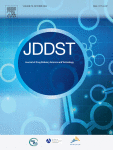
Designing electrospun shellac nanofibers with mupirocin using the Box-Behnken approach for topical wound care (2022)
Title : Designing electrospun shellac nanofibers with mupirocin using the Box-Behnken approach for topical wound care
Researcher : Nawinda Chinatangkul, Sirikarn Pengon,Wantanwa Krongrawa, Siraprapa Chansatidkosol, Chutima Limmatvapirat and Sontaya Limmatvapirat
Link to article: Journal of Drug Delivery Science and Technology, Volume 76, Issue 103720, 31 August 2022, Pages 1-8. https://doi.org/10.1016/j.jddst.2022.103720
Citation : Chinatangkul N., Pengon S., Chatsuwan T., Krongrawa W., Chansatidkosol S., Limmatvapirat C. and Limmatvapirat S. (2022). Designing electrospun shellac nanofibers with mupirocin using the Box-Behnken approach for topical wound care. Journal of Drug Delivery Science and Technology, 76(103720), 1-8. https://doi.org/10.1016/j.jddst.2022.103720
Journal : Journal of Drug Delivery Science and Technology / in Scopus
ฐานข้อมูลงานวิจัย มหาวิทยาลัยสยาม : https://e-research.siam.edu/kb/designing-electrospun-shellac/

Determination of mono-, di-, and trilaurin in modified coconut oil using HPLC–ELSD (2016)
Abstract
Modified coconut oil (MCO) enriched with monolaurin (ML) was prepared by the glycerolysis of coconut oil [1]. Glycerolysis converts dilaurin (DL) and trilaurin (TL) into ML, the lauric acidmonoglyceride. ML has been found to have antiviral, antibacterial and antifungal activities[2]. According to the antimicrobial activity, the glyceride composition of MCO was determined. The concentrations of ML, DL, and TL in MCO were analyzed using high-performance liquid chromatography–evaporative light scattering detector (HPLC–ELSD).
The HPLC–ELSD analyses were performed using an HPLC 1200 series equipped with an ELSD and a ZORBAX Eclipse Plus C18 column (4.6 × 250 mm, 5 µm) from Agilent Technologies Inc. The mobile phase consisted of 0.01% (v/v) acetic acid in acetonitrile(solvent A) and acetone (solvent B) and was degassed by ultrasonic bath prior to use. The HPLC column temperature was 25 °C. The mobile phase was maintained at a flow rate of 1.0 ml/min with the following gradient condition: solvent A:solvent B (90:10 v/v) from 0 to 5 min to solvent A:solvent B (70:30 v/v) from 5 to 10 min to solvent A:solvent B (50:50 v/v) from 10 to 15 min to solvent A:solvent B (30:70 v/v) from 15 to 20 min to solvent A:solvent B (20:80 v/v), and then held for 10 min. The equilibration time between runs was 10 min and the injection volume used was 10 µl. The temperature of the nebulization was set at 40 °C and nitrogen gas was 3.5 bar.
The ELSD were capable of a linear response (R2 > 0.9995) independent of individual glyceride molecular structures at concentrations between ~0.02 and 0.40 mg/ml. Intra- and inter-day reproducibility (n = 5) were evaluated under the optimized conditions. The relative standard deviations for glycerides were less than 2.45%. The detection limits (LODs) and the quantification limits (LOQs) were lower than 0.054 and 0.162 mg/ml, respectively. The efficiency of this method, measured through the recoveries, was higher than 96.06%. The elution order of the standards was ML < DL < TL as shown in Fig. 1. The DL and TL standards eluted after the ML standard, indicating that the hydroxyl moiety on the glycerol backbone contributed significantly to retention. The concentrations of ML, DL, and TL of MCO derived from various conditions of glycerolysis were in the ranges of 102.70–247.25 mg/ml (ML), 52.65–79.87 mg/ml (DL), and 12.27–39.60 mg/ml (TL).
Keywords: Monolaurin, Dilaurin, Trilaurin, Modified coconut oil, HPLC–ELSD
Link to Publication: https://www.sciencedirect.com/science/article/pii/S1818087615001889
Bibliography : Juthaporn Ponphaiboon, Sirikarn Pengon, Amornrat Chaidedgumjorn, Sontaya Limmatvapirat and Chutima Limmatvapirat. (2016). Determination of mono-, di-, and trilaurin in modified coconut oil using HPLC–ELSD. Asian Journal of Pharmaceutical Sciences, 11(1), 223-224. (conference abstract).
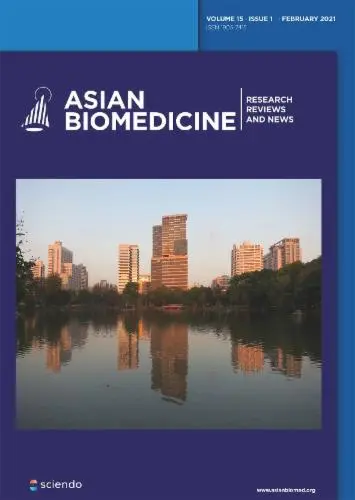
Determining safe entry sites for filler injections on the lateral canthal vertical line: Anatomical study of the midface arterial perforators in soft embalmed cadavers (2016)
Title : Determining safe entry sites for filler injections on the lateral canthal vertical line: Anatomical study of the midface arterial perforators in soft embalmed cadavers
Researcher : Rungsawang, C., Tansatit, T., Phumyoo, T., Jitaree, B., Uruwan, S.
Abstract : Background: Filler injections are frequently associated with vascular complications.Objectives: To investigate the course and location of the middle-midface perforators to establish safe cannulaentry sites for filler injections.Methods: The middle-midface was studied using 28 hemiface specimens from soft embalmed Thai cadavers atthe Faculty of Medicine, Chulalongkorn University. Investigations were performed following injection of red latex.Results: Middle-midface perforators were classified into 3 groups according to their origin. These perforatorsoriginated from the buccal branch of the facial artery (57%); the parotid artery (25%); or directly from the facialartery (18%). The distance between the buccal artery perforator (level with the upper alar crease) and the lateralcanthal (Y axis) line was 2.6 (SD 6.0) mm and Frankfort’s horizontal (X axis) lines was −16.4 (5.4) mm. The distancebetween the parotid artery perforator and the lateral canthal vertical line was 4.2 (10.8) mm and Frankfort’shorizontal line was −13.9 (3.4) mm. The distance between the facial artery perforator and the lateral canthal verticalline was 11.2 (10.8) and Frankfort’s horizontal line was –16.0 (5.3) mm.Conclusions: A single long perforator was identified along the lateral canthal vertical line. This most commonlyoriginated from the buccal branch emerging from the facial artery. Therefore, we recommend a cannula be insertedat the Beut site 2 cm inferolateral to the lateral canthus. This injection site is recommended as a safe to avoidinjury to the middle-midface perforato
Keywords: Facial artery perforator, filler injection technique, injectable filler complications, midface volumizati
Link to Academic article: https://sciendo.com/article/10.5372/1905-7415.1006.532
Journal : Asian Biomedicine, 2016, 10(6),
Bibliography : Rungsawang, C., Tansatit, T., Phumyoo, T., Jitaree, B., & Uruwan, S. (2016). Determining safe entry sites for filler injections on the lateral canthal vertical line: Anatomical study of the midface arterial perforators in soft embalmed cadavers. Asian Biomedicine, 10(6), 619–625.

Development of Encapsulated Wasabi Flavor for Resistance in High Temperature Condition (2023)
Title : Development of Encapsulated Wasabi Flavor for Resistance in High Temperature Condition
Researcher : Chintong, S., Sukosi, K., Saengrung, J., Limpawattana, M., Klaypradit, W.
Department : สำนักอธิการบดี มหาวิทยาลัยสยาม
E-mail : maruj.lim@siam.edu
ฐานข้อมูลงานวิจัย มหาวิทยาลัยสยาม : –
Link to article: Trends in Sciences, 2023, 20(9), 6758. https://doi.org/10.48048/tis.2023.6758
Journal : Trends in Sciences / in Scopus
Bibliography : Chintong, S. ., Sukosi, K. ., Saengrung, J. ., Limpawattana, M. ., & Klaypradit, W. . (2023). Development of Encapsulated Wasabi Flavor for Resistance in High Temperature Condition. Trends in Sciences, 20(9), 6758. https://doi.org/10.48048/tis.2023.6758
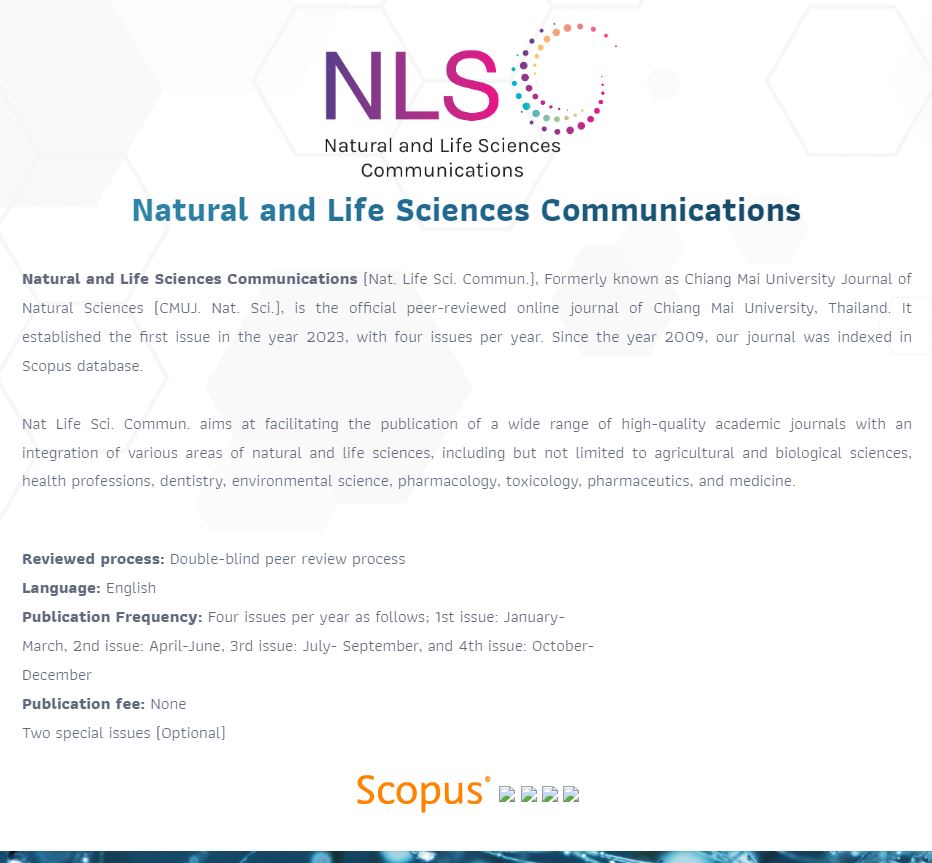
Development of Gummy Jelly Incorporated with Lysiphyllum strychnifolium Leaf Extract and Its Antioxidant and α-Glucosidase Inhibitory Activities (2023)
Title : Development of Gummy Jelly Incorporated with Lysiphyllum strychnifolium Leaf Extract and Its Antioxidant and α-Glucosidase Inhibitory Activities
Researcher : Thavaree Thilavech, Achira Sutiyaporn, Pimpikar Kanchanadumkerng, Vilasinee Hirunpanich Sato, Warisara Parichatikanond, Phennapa Charoenwiwattanakij & Savita Chewchinda
Link to article : Natural and Life Sciences Communications, Volume 22, Issue 2, April-June 2023 pages 1-14. https://doi.org/10.12982/NLSC.2023.019
Journal : Natural and Life Sciences Communications / in Scopus
Citation : Thilavech T, Sutiyaporn A, Kanchanadumkerng P, Sato V.H., Parichatikanond W, Charoenwiwattanakij P & Chewchinda S. (2023). Development of Gummy Jelly Incorporated with Lysiphyllum strychnifolium Leaf Extract and Its Antioxidant and α-Glucosidase Inhibitory Activities. Natural and Life Sciences Communications, 22(2), 1-14. https://doi.org/10.12982/NLSC.2023.019
ฐานข้อมูลงานวิจัย มหาวิทยาลัยสยาม : https://e-research.siam.edu/kb/development-of-gummy-jelly-incorporated/
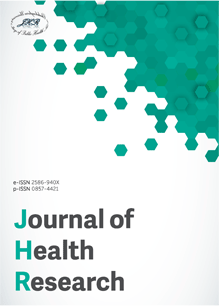
Development of Multidisciplinary Care Model with Participatory Action Research for Heart Failure Clinic in Bangkok, Thailand (2023)
Title : Development of Multidisciplinary Care Model with Participatory Action Research for Heart Failure Clinic in Bangkok, Thailand
Researcher : Usasiri Srisakul,Warawut Umpornwirojkit, Supaporn Pattanasan,Apichot So-ngern, Charlermsri Pummangura & Sarawut Siwamogsatham
Link to article: Journal of Health Research, Volume 37, Issue 5, pages 358-371. https://digital.car.chula.ac.th/jhr/vol37/iss5/11/
Journal : Journal of Health Research / Scopus
Citation : Srisakul U., Umpornwirojkit W., Pattanasan S., So-ngern A., Pummangura C., & Siwamogsatham S. (2023). Development of multidisciplinary care model with participatory action research for heart failure clinic in Bangkok, Thailand. Journal of Health Research, 37(5), 358-371.
ฐานข้อมูลงานวิจัย มหาวิทยาลัยสยาม : https://e-research.siam.edu/kb/development-of-multidisciplinary-care/